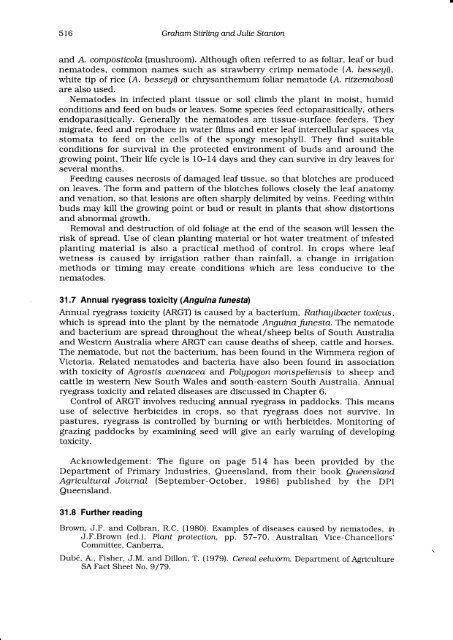NEMATODE DISEASES AND THEIR CONTROL Graham Stirling ...
NEMATODE DISEASES AND THEIR CONTROL Graham Stirling ...
NEMATODE DISEASES AND THEIR CONTROL Graham Stirling ...
Create successful ePaper yourself
Turn your PDF publications into a flip-book with our unique Google optimized e-Paper software.
516 <strong>Graham</strong> Strrling andJuLie Stanton<br />
and A. composticolo (mushroom). Although often referred to as foliar, leaf or bud<br />
nematodes, common names such as strawberry crimp nematode (A. bessegil,<br />
white tip of rice (A. bessegt) or chrysanthemum foliar nematode (A. rttzemabosil<br />
are also used.<br />
Nematodes in infected plant tissue or soil climb the plant in moist, humid<br />
conditions and feed on buds or leaves. Some species feed ectoparasitically, others<br />
endoparasitically. Generally the nematodes are tissue-surface feeders. They<br />
migrate, feed and reproduce in water films and enter leaf intercellular spaces via<br />
stomata to feed on the cells of the spongy mesophyll. They find suitable<br />
conditions for survival in the protected environment of buds and around the<br />
growing point. Their life cycle is lO-14 days and they can suryive in dry leaves for<br />
several months.<br />
Feeding causes necrosis of damaged leaf tissue, so that blotches are produced<br />
on leaves. The form and pattern of the blotches follows closely the leaf anatomy<br />
and venation, so that lesions are often sharply delimited by veins. Feeding within<br />
buds may kill the growing point or bud or result in plants that show distortions<br />
and abnormal growth.<br />
Removal and destruction of old foliage at the end of the season will lessen the<br />
risk of spread. Use of clean planting material or hot water treatment of infested<br />
planting material is also a practical method of control. In crops where leaf<br />
wetness is caused by irrigation rather than rainfall, a change in irrigation<br />
methods or timing may create conditions which are less conducive to the<br />
nematodes.<br />
31.7 Annual ryegrass toxicity (Anguina tunesta)<br />
Annual ryegrass toxicity (ARGT) is caused by a bacterium, Rathagtbacter toxicus,<br />
which is spread into the plant by the nematode Anguina funesta. The nematode<br />
and bacterium are spread throughout the wheat/sheep belts of South Australia<br />
and Western Australia where ARGT can cause deaths of sheep, cattle and horses.<br />
The nematode, but not the bacterium, has been found in the Wimmera region of<br />
Victoria. Related nematodes and bacteria have also.been found in association<br />
with toxicity of Agrostis auenacea and PoLgpogon monspeliensis to sheep and<br />
cattle in western New South Wales and south-eastern South Australia. Annual<br />
ryegrass toxicity and related diseases are discussed in Chapter 6.<br />
Control of ARGT involves reducing annual ryegrass in paddocks. This means<br />
use of selective herbicides in crops, so that ryegrass does not survive. In<br />
pastures, ryegrass is controlled by burning or with herbicides. Monitoring of<br />
grazing paddocks by examining seed will give an early warning of developing<br />
toxicity.<br />
Acknowledgement: The figure on page 514 has been provided by the<br />
Department of Primary Industries, Queensland, from their book Queensland<br />
Agricultural JournaL (September-October, 1986) published by the DPI<br />
Queensland.<br />
31.8 Further reading<br />
Brown, J.F. and Colbran, R.C. (1980). Examples of diseases caused by nematodes, n<br />
J.F.Brown (ed.), Plant protectton, pp. 57-7O. Australian Vice-Chancellors'<br />
Committee, Canberra.<br />
Dube, A., Fisher, J.M. and Dillon, T. (1979). Cereal eebuornt Department of Agriculture<br />
SA Fact Sheet No. 9/79.






![[Compatibility Mode].pdf](https://img.yumpu.com/27318716/1/190x135/compatibility-modepdf.jpg?quality=85)










